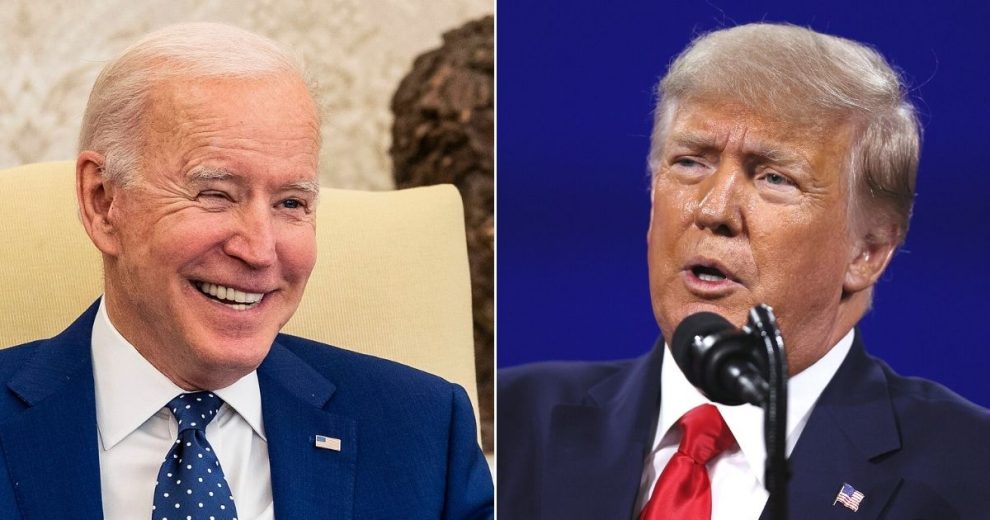“Do you miss me yet?” former President Donald Trump asked an adoring CPAC crowd in Orlando, Florida, in February weeks after Joe Biden took office.
The answer then and now, four months into the new administration, is a resounding, “Yes!”
"Do you miss me yet?" President Trump says as he takes the stage at #CPAC pic.twitter.com/QrruARn2Da
— Daily Caller (@DailyCaller) February 28, 2021
Whether the issue is the economy, immigration or foreign policy, Trump far outshines his successor.
From the day Biden assumed the presidency, he has been making decisions that have hurt all three.
You’ll recall a slew of executive orders, including canceling the Keystone XL pipeline, placing a moratorium on oil and gas exploration on federal land, stopping construction on the border wall and ending the Trump administration’s “Remain in Mexico” policy.
All are beginning to have disastrous consequences.
Then, of course, came the $1.9 trillion American Rescue Plan Act, which the Democratic Congress passed and Biden signed into law in March.
On the foreign policy front, the Biden administration has taken a softer approach in dealing with Iran, signaling its desire to re-enter the Joint Comprehensive Plan of Action concerning the Islamic republic’s nuclear weapons development.
If only Biden would have more broadly followed the old maxim, “If it ain’t broke, don’t fix it.”
He did with regard to the COVID vaccine rollout, but not for most everything else.
Biden received his highest marks in recent polling for his handling of the coronavirus. Even nearly half of the Republicans surveyed approved of his handling of the pandemic, according to the Associated Press/NORC poll.
Oh, if he had only taken the same tack regarding the economy, immigration and foreign policy.
Prior to the COVID-19 shutdowns, the United States was experiencing some of its best economic numbers in a long time, including a 3.5 percent unemployment rate — a half-century low.
With Trump’s pro-growth tax and regulatory policies still in place, the economy rebounded strongly following the COVID shutdowns of last spring.
The unemployment rate fell to 6 percent in March from a peak of 14.8 percent in April 2020.
Last month, it ticked back up to 6.1 percent, with 266,000 jobs added, well short of the nearly one million economists anticipated as COVID restrictions continued to lift.
The figure was also less than half of the 770,000 added in March and the 536,000 in February.
One reason is clearly the enhanced federal unemployment benefits, which were due to expire in March, but which the American Rescue Plan Act extended until September.
No reason to rush back into the workforce if you can earn as much or more staying at home, right?
Additionally, inflation leaped 4.2 percent in April, the fastest increase of the Consumer Price Index since 2008, CNBC reported.
What was leading to the spike in prices for the American consumer? Surprise, surprise — energy costs. They were up 25 percent in April from a year ago, with gasoline jumping a whopping 49.6 percent.
When Biden ended construction of the Keystone XL pipeline and oil development on federal lands, it sent a signal to the market that the U.S. — the world’s top producer — will be providing less in the future.
Less supply coupled with higher demand equals rising prices. Pretty basic stuff.
The cost of energy also impacts the price of food, which must be harvested and transported to market using gasoline. Food prices are up 3.5 percent compared to last spring.
A further inflationary pressure is all the deficit spending, which is being funded, in large measure, by the Federal Reserve printing money.
In a February piece for The Wall Street Journal, economists John Greenwood and Steve H. Hanke noted the quantity of money in the U.S. economy increased $4 trillion from February 2020 to February 2021, or 26 percent. That’s the largest annual increase since the middle of World War II in 1943.
Hundreds of billions of these dollars went right into Americans’ bank accounts through stimulus payments and unemployment benefits as well as the coffers of state and local governments.
That money is then spent, which of course is good at one level, but at another, if there are too many dollars chasing too few goods and services, prices will rise.
Inflation through devaluing the currency hits all Americans, but lower-income ones the hardest.
Despite this incontrovertible truth, Biden seeks to spend trillions more to expand existing government benefits and create new ones.
Don’t believe Biden’s promise that only the wealthy and corporations will have to pay, because we’re witnessing right now that claim is false.
The president’s immigration policies have been equally as disastrous as his economic ones.
The border was well on its way to being secured with Trump’s policies in place.
Biden threw it all out and actually incentivized a massive surge of unaccompanied minors to the southern border.
Customs and Border Protection reported having 178,622 encounters in April.
That was the highest number in a single month since April 2000.
The #BidenBorderCrisis continues to deteriorate:
February: 101,120 illegal alien apprehensions
March: 173,348 illegal alien apprehensions
April: 178,622 illegal alien apprehensions
This is a catastrophe on the border. https://t.co/YOBZ1SLc4r
— Ted Cruz (@tedcruz) May 12, 2021
Finally, in the area of foreign policy, Biden has shown himself to be dangerously inept.
During Trump’s final months in office, peace was breaking out all over the Middle East thanks to the Abraham Accords between Israel and various Arab nations, which the Trump administration brokered.
One of the factors bringing these nations together was Trump’s strong stand against Iran, including his decision to pull out of the flawed nuclear deal, joined with the imposition of crippling economic sanctions.
Pres. Trump and leaders from Israel, Bahrain and the U.A.E. participate in the signing of the Abraham Accords, normalizing relations between Israel and the two Arab nations. https://t.co/tT3RjWUHND pic.twitter.com/UkxVwFGHjp
— ABC News (@ABC) September 15, 2020
Trump predicted last summer that if he won re-election, Tehran would be ready to negotiate.
Biden frittered much of this leverage away by signaling that he wants to re-enter the Iran nuclear deal.
GOP Sen. Lindsey Graham of South Carolina and former Trump State Department spokesperson Morgan Ortagus, in a piece for Foreign Policy last month, wrote that if Biden moves forward with re-entering the JCPOA and removing the sanctions, it would mean a $90 billion boon for the Iranians.
Iran is the top state sponsor of terror and one of the funders of the Palestinian terror group Hamas, which is behind the current rocket attacks on Israel.
The last 48 hours in Israel: pic.twitter.com/cEHq69Py4y
— Israel Defense Forces (@IDF) May 12, 2021
There is one thing these past four months have shown us: the difference between competent and incompetent leadership at 1600 Pennsylvania Avenue.
The last time the nation’s commander in chief seemed so unmatched to the tasks at hand was under President Jimmy Carter in the late 1970s.
However, in a statement issued Wednesday, Trump argued comparing Biden to Carter is unfair to the latter.
“Jimmy mishandled crisis after crisis, but Biden has created crisis after crisis,” Trump said.
“First there was the Biden Border Crisis (that he refuses to call a Crisis), then the Biden Economic Crisis, then the Biden Israel Crisis, and now the Biden Gas Crisis,” he continued.
“Joe Biden has had the worst start of any president in United States history, and someday, they will compare future disasters to the Biden Administration—but no, Jimmy was better!” the 45th president concluded.
One thing is for certain: We will need either Trump to return or another Reagan-esque figure to step forward when Biden’s finished and pull us out of the morass he’s driving us into.
Story cited here.
























